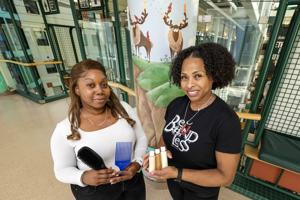When patients are admitted to the Hospital for Sick Children’s 7A unit, they’re separated from any belongings they came in with and are given a pair of pyjamas and a hygiene kit containing the basics. But soon after joining the unit, Donnette Reynolds said she realized “the basics weren’t actually the basics” for everyone, and it was affecting patients’ self-esteem. For Black and biracial kids, the products were “making their skin dry, their hair dry, which made it difficult for them to even start engaging in treatment because they didn’t feel well put together,” Reynolds, one of the unit’s child and youth counsellors, explained to the Star.
To make those patients in the unit, which specializes in mental health and eating disorders, more comfortable, Reynolds and her colleagues, Latoya Palmer and Danielle Tabar, began making hygiene and hair care more accessible. They began purchasing things like moisturizing shampoos, conditioners and lotions, and brushes and combs by themselves, on a case-by-case basis. In one instance, Reynolds said she noticed a patient who always seemed to be hiding behind a hat, wasn’t interested in engaging in their treatment program and was keeping to themselves.

In an effort to coax them out of their shell, she offered to teach them about taking care of their hair, walking them through washing, conditioning and moisturizing, and helping put it in braids afterward so it would be easier to manage for the rest of their stay. “It totally changed how they saw themselves,” she said. Eventually, the three colleagues were able to start buying what they needed in larger quantities using the unit’s credit card, allowing them to help patients consistently.
Last summer, the project became known as the SickKids Hair Equity Initiative and earned Reynolds, Palmer and Tabar the hospital’s 2024 President’s Award. A working group is looking into how it can be adopted hospital-wide. The SickKids Hair Equity Initiative ensures Black and biracial patients in the hospital’s 7A unit have the supplies they need to keep their hair healthy during their stay.
Products previously offered often left patients’ hair dry and unmanageable, discouraging them from participating in their treatment. The three counsellors work in the hospital’s 7A unit, which typically involves overnight stays alone. Patients “usually come to us with nothing,” said Reynolds.
“They may be coming up from (the emergency department) or they’re coming up with police, so they’re not coming prepared to stay.” One product they realized their Black and biracial patients could benefit from was wide-tooth combs. Previously, only fine-tooth “tiny, little combs” were available.
Reynolds said they’re similar in size to those used when checking for lice, and aren’t suitable for styling or detangling curly or afro-textured hair, potentially causing damage. “We want (our patients) to know they matter,” said Reynolds. “It’s the simple things that make a difference.
” Palmer explained that families and caregivers often bring their child’s belongings and care products for them the day after they’ve been admitted, but sometimes patients come from far away , have financial constraints, or may have been homeless before arriving, so the kits contain anything they may need during their stay. In many Black families, children grow up having the importance of “looking presentable” instilled in them, and mental health issues come with stigma , she said. Combined, these factors make it harder for Black and biracial patients “to think about engaging in therapy when you don’t feel good within yourself — not internally, and definitely not externally,” Palmer explained.
“It’s not just hair, it’s self-esteem,” she said. “It’s a confidence booster. It’s part of their individuality.
” In the U.S., several states made race-based hair discrimination illegal, but north of the border The significance hair holds for Black youth, and girls in particular, is not lost on Beverly-Jean Daniel, an associate professor in the school of child and youth care at Toronto Metropolitan University.
She told the Star neglected hair came up consistently as a source of trauma while she was doing a research project on the experiences of Black girls who had aged out of the foster care system. Many of those she spoke with were placed with non-Black families, who didn’t understand how to take care of their hair, said Daniel. “How can you stand tall when your hair — your crown — is not being effectively cared for,” she wondered.
Daniel noted hairstyles that might seem easy and low-maintenance for people with straight hair to achieve often aren’t for people with afro-textured hair. “When a white woman pulls her hair up without brushing or combing it, it becomes a messy bun,” which is generally viewed as an acceptable hairstyle, “but our hair isn’t built in the same way,” she said. “We need to invest more time in our hair and caring” for it.
Black hair “is not complex to us, but it is compared to the rest of the world because they just don’t understand,” said Daniel. As part of the Star’s ongoing Toronto the Better initiative, this year we’ll highlight the people and organizations making a difference in the GTA and share volunteering opportunities that can inspire real change. Know of a person or group deserving of the spotlight? Email torontothebetter@thestar.
ca.
Top

Children in a SickKids unit weren't opening up in therapy. How hair products helped these counsellors find a breakthrough

A project in a mental health and eating disorders unit is helping Black and biracial kids. "It totally changed how they saw themselves."











